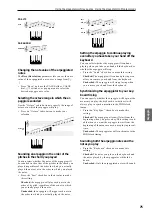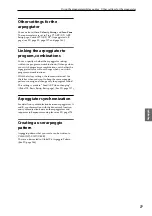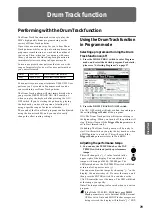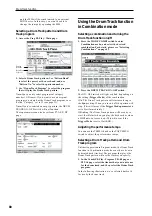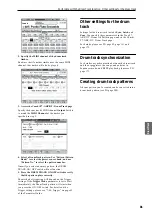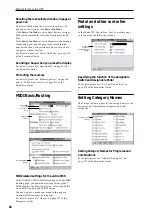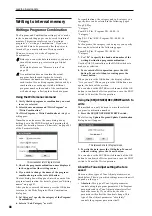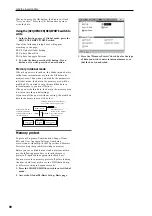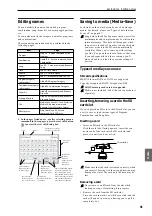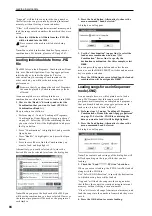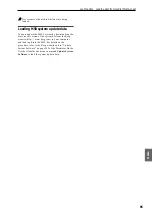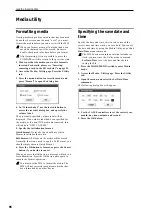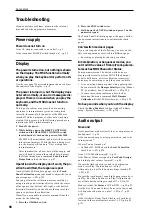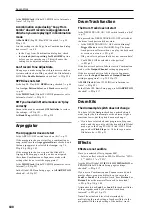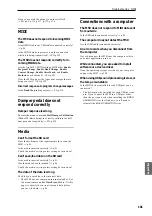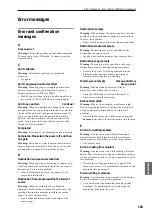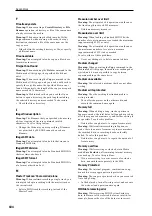
Saving data Writing to internal memory
89
Program
Combination
Sequencer
Effect
Arpeggio
Drum Track
Global
Media
• Relative: This type of Tone Adjust parameter
controls two or more program parameters
simultaneously. For example, “Filter/Amp EG
Attack Time” controls a total of six program
parameters. The value of a relative parameter
indicates the amount of change that is applied to
the value of each program parameter it’s affecting.
When a relative parameter is at zero (i.e., when its
slider is in the center position), the program
parameters it controls will function according to
their original settings. Raising or lowering the value
of a relative parameter will indirectly raise or lower
the value of these program parameters.
• Meta: This type of Tone Adjust parameter affects
other Tone Adjust parameters. It does not affect
program parameters directly.
If you’ve adjusted an absolute or a relative Tone Adjust
parameter, the result of your adjustment will be
written as follows.
Program mode:
• The settings of relative-type Tone Adjust
parameters are automatically applied directly to the
program parameters when you write the program.
The Tone Adjust values will be reset to zero.
• The settings of absolute-type Tone Adjust
parameters are written “as themselves” (i.e., as the
new settings of those Tone Adjust parameters).
Combination mode:
• The settings of both relative-type and absolute-type
Tone Adjust parameters are written and preserved
as the Tone Adjust settings for each timbre.
For details, please see “0–7: Tone Adjust” on page 6,
page 85 of the Parameter Guide.
About the Program and Combination edit
buffer
When you select a program in Prog P0: Play or a
combination in Combi P0: Play, the program or
combination data is called into the M50’s edit buffer.
When you then use the various Program or
Combination pages to edit the parameters, your
changes will affect the data in the edit buffer.
If you wish to save this modified data into internal
memory, you must perform the Write operation.
When you perform the Write operation, the data in the
edit buffer is written to the specified program or
combination number of the specified bank.
If you select another program or combination without
writing your edits, the data of the newly selected
program or combination will overwrite the edited data
in the edit buffer, and your changes will be lost.
Note:
When you press the COMPARE switch in
Program mode, or Combination mode, the data from
memory (i.e., the contents that were written into
memory) will be temporarily called into the edit buffer.
This allows you to compare the settings you are editing
with the original un-edited settings.
Writing Global settings, User Drum
Kits and User Arpeggio Patterns
The settings you edit in Global mode can be written
into internal memory. This is done using the operations
Write Global Setting, Write User Drum Kits, and User
Arpeggio Patterns. If you wish to keep these edited
settings after you turn the power off, be sure to write
the data first.
There are two ways to write global settings: User Drum
Kits and User Arpeggio Pattern.
Using a menu command to write
1. To write global settings (the various settings in
Global P0–P4), press the menu command “Write
Global Setting” in Global P0–P4.
Note:
Alternatively, you can access the same dialog
box by holding down the ENTER switch and pressing
the 0 switch. For details, please see“Shortcuts” on
page 405 of the Parameter Guide.
The Write Global Setting dialog box will appear.
The Effect Global SW setting is not saved.
To write the Drum Kits (the settings of Global P0–P4),
choose the menu command Write Drum Kits in Global
P5.
The Write Drum Kits dialog box will appear.
To write the User Arpeggio Patterns (the setting of
Global P6), choose the menu command Write
Arpeggio Pattern
in Global P6.
The Write Arpeggio Pattern dialog box will appear.
2. To write the data, press the OK button. If you
decide not to write, press the Cancel button.
Edit Buffer
Write
Select
Internal Memory
Edit
Program
A 0...127
Combination
A 0...127
When you write, the
program or combination
settings will be saved in
internal memory.
When you select a program
or combination, its data is
called from internal memory
into the edit buffer.
Editing applies to the data in the edit
buffer. Programs or combinations will
play according to the data in the edit
buffer.
Summary of Contents for EASYSTART M50
Page 1: ...3 E Owner s Manual ...
Page 84: ...Arpeggiator function 78 ...
Page 88: ...Drum Track function 82 ...

